Solar eclipse of October 10, 1912
A total solar eclipse occurred at the Moon's descending node of orbit on Thursday, October 10, 1912,[1][2][3][4] with a magnitude of 1.0229. A solar eclipse occurs when the Moon passes between Earth and the Sun, thereby totally or partly obscuring the image of the Sun for a viewer on Earth. A total solar eclipse occurs when the Moon's apparent diameter is larger than the Sun's, blocking all direct sunlight, turning day into darkness. Totality occurs in a narrow path across Earth's surface, with the partial solar eclipse visible over a surrounding region thousands of kilometres wide. Occurring about 2.8 days after perigee (on October 7, 1912, at 18:50 UTC), the Moon's apparent diameter was larger.[5]
Totality was visible from Ecuador, Colombia, northern tip of Peru and Brazil. A partial eclipse was visible for parts of Central America, the Caribbean, South America, Antarctica, and Southern Africa.
Observation
German physicist, mathematician and astronomer Johann Georg von Soldner calculated the gravitational lens effect in an article published in 1801. Albert Einstein got similar values in 1911, and proposed verifying it by observing the stars around the sun. The only feasible way at that time was observing during a total solar eclipse, when the sun is totally blocked. This was the first total solar eclipse after that.[6] Local teams from Brazil and international teams from the United Kingdom, France, the German Empire, Argentina and Chile made attempts in Brazil. However, it rained throughout almost the whole path of totality, and all teams failed.[7]
Eclipse details
Shown below are two tables displaying details about this particular solar eclipse. The first table outlines times at which the moon's penumbra or umbra attains the specific parameter, and the second table describes various other parameters pertaining to this eclipse.[8]
| Event | Time (UTC) |
|---|---|
| First Penumbral External Contact | 1912 October 10 at 10:57:15.4 UTC |
| First Umbral External Contact | 1912 October 10 at 11:58:42.7 UTC |
| First Central Line | 1912 October 10 at 11:58:57.3 UTC |
| First Umbral Internal Contact | 1912 October 10 at 11:59:12.0 UTC |
| First Penumbral Internal Contact | 1912 October 10 at 13:16:22.6 UTC |
| Greatest Duration | 1912 October 10 at 13:35:21.8 UTC |
| Greatest Eclipse | 1912 October 10 at 13:36:13.5 UTC |
| Ecliptic Conjunction | 1912 October 10 at 13:40:37.9 UTC |
| Last Penumbral Internal Contact | 1912 October 10 at 13:55:30.8 UTC |
| Equatorial Conjunction | 1912 October 10 at 14:00:01.6 UTC |
| Last Umbral Internal Contact | 1912 October 10 at 15:13:03.4 UTC |
| Last Central Line | 1912 October 10 at 15:13:15.6 UTC |
| Last Umbral External Contact | 1912 October 10 at 15:13:27.7 UTC |
| Last Penumbral External Contact | 1912 October 10 at 16:15:07.6 UTC |
| Parameter | Value |
|---|---|
| Eclipse Magnitude | 1.02287 |
| Eclipse Obscuration | 1.04625 |
| Gamma | −0.41487 |
| Sun Right Ascension | 13h02m12.2s |
| Sun Declination | -06°38'03.1" |
| Sun Semi-Diameter | 16'01.4" |
| Sun Equatorial Horizontal Parallax | 08.8" |
| Moon Right Ascension | 13h01m25.4s |
| Moon Declination | -06°59'39.3" |
| Moon Semi-Diameter | 16'08.7" |
| Moon Equatorial Horizontal Parallax | 0°59'15.3" |
| ΔT | 14.3 s |
Eclipse season
This eclipse is part of an eclipse season, a period, roughly every six months, when eclipses occur. Only two (or occasionally three) eclipse seasons occur each year, and each season lasts about 35 days and repeats just short of six months (173 days) later; thus two full eclipse seasons always occur each year. Either two or three eclipses happen each eclipse season. In the sequence below, each eclipse is separated by a fortnight.
| September 26 Ascending node (full moon) | October 10 Descending node (new moon) |
|---|---|
 |  |
| Partial lunar eclipse Lunar Saros 116 | Total solar eclipse Solar Saros 142 |
Related eclipses
Eclipses in 1912
- A partial lunar eclipse on April 1.
- A hybrid solar eclipse on April 17.
- A partial lunar eclipse on September 26.
- A total solar eclipse on October 10.
Metonic
- Preceded by: Solar eclipse of December 23, 1908
- Followed by: Solar eclipse of July 30, 1916
Tzolkinex
- Preceded by: Solar eclipse of August 30, 1905
- Followed by: Solar eclipse of November 22, 1919
Half-Saros
- Preceded by: Lunar eclipse of October 6, 1903
- Followed by: Lunar eclipse of October 16, 1921
Tritos
- Preceded by: Solar eclipse of November 11, 1901
- Followed by: Solar eclipse of September 10, 1923
Solar Saros 142
- Preceded by: Solar eclipse of September 29, 1894
- Followed by: Solar eclipse of October 21, 1930
Inex
- Preceded by: Solar eclipse of October 30, 1883
- Followed by: Solar eclipse of September 21, 1941
Triad
- Preceded by: Solar eclipse of December 9, 1825
- Followed by: Solar eclipse of August 11, 1999
Solar eclipses of 1910–1913
This eclipse is a member of a semester series. An eclipse in a semester series of solar eclipses repeats approximately every 177 days and 4 hours (a semester) at alternating nodes of the Moon's orbit.[9]
The partial solar eclipse on August 31, 1913 occurs in the next lunar year eclipse set.
| Solar eclipse series sets from 1910 to 1913 | ||||||
|---|---|---|---|---|---|---|
| Ascending node | Descending node | |||||
| Saros | Map | Gamma | Saros | Map | Gamma | |
| 117 | May 9, 1910 Total | −0.9437 | 122 | November 2, 1910 Partial | 1.0603 | |
| 127 | April 28, 1911 Total | −0.2294 | 132 | October 22, 1911 Annular | 0.3224 | |
| 137 | April 17, 1912 Hybrid | 0.528 | 142 | October 10, 1912 Total | −0.4149 | |
| 147 | April 6, 1913 Partial | 1.3147 | 152 | September 30, 1913 Partial | −1.1005 | |
Saros 142
This eclipse is a part of Saros series 142, repeating every 18 years, 11 days, and containing 72 events. The series started with a partial solar eclipse on April 17, 1624. It contains a hybrid eclipse on July 14, 1768, and total eclipses from July 25, 1786 through October 29, 2543. There are no annular eclipses in this set. The series ends at member 72 as a partial eclipse on June 5, 2904. Its eclipses are tabulated in three columns; every third eclipse in the same column is one exeligmos apart, so they all cast shadows over approximately the same parts of the Earth.
The longest duration of totality will be produced by member 38 at 6 minutes, 34 seconds on May 28, 2291. All eclipses in this series occur at the Moon’s descending node of orbit.[10]
| Series members 11–32 occur between 1801 and 2200: | ||
|---|---|---|
| 11 | 12 | 13 |
 August 5, 1804 |  August 16, 1822 |  August 27, 1840 |
| 14 | 15 | 16 |
 September 7, 1858 | 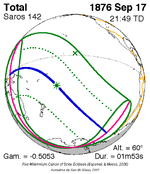 September 17, 1876 |  September 29, 1894 |
| 17 | 18 | 19 |
 October 10, 1912 |  October 21, 1930 |  November 1, 1948 |
| 20 | 21 | 22 |
 November 12, 1966 |  November 22, 1984 |  December 4, 2002 |
| 23 | 24 | 25 |
 December 14, 2020 |  December 26, 2038 |  January 5, 2057 |
| 26 | 27 | 28 |
 January 16, 2075 |  January 27, 2093 | 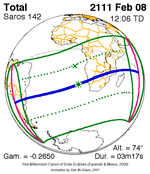 February 8, 2111 |
| 29 | 30 | 31 |
 February 18, 2129 |  March 2, 2147 |  March 12, 2165 |
| 32 | ||
 March 23, 2183 | ||
Metonic series
The metonic series repeats eclipses every 19 years (6939.69 days), lasting about 5 cycles. Eclipses occur in nearly the same calendar date. In addition, the octon subseries repeats 1/5 of that or every 3.8 years (1387.94 days). All eclipses in this table occur at the Moon's descending node.
| 22 eclipse events between March 5, 1848 and July 30, 1935 | ||||
|---|---|---|---|---|
| March 5–6 | December 22–24 | October 9–11 | July 29–30 | May 17–18 |
| 108 | 110 | 112 | 114 | 116 |
 March 5, 1848 |  July 29, 1859 |  May 17, 1863 | ||
| 118 | 120 | 122 | 124 | 126 |
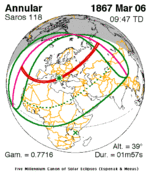 March 6, 1867 |  December 22, 1870 |  October 10, 1874 | 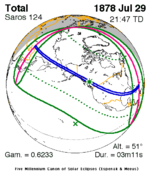 July 29, 1878 |  May 17, 1882 |
| 128 | 130 | 132 | 134 | 136 |
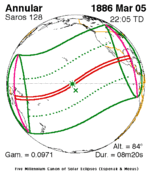 March 5, 1886 | 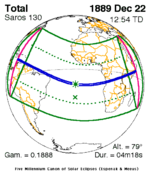 December 22, 1889 |  October 9, 1893 |  July 29, 1897 |  May 18, 1901 |
| 138 | 140 | 142 | 144 | 146 |
 March 6, 1905 |  December 23, 1908 |  October 10, 1912 |  July 30, 1916 |  May 18, 1920 |
| 148 | 150 | 152 | 154 | |
 March 5, 1924 |  December 24, 1927 |  October 11, 1931 | 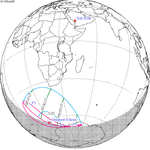 July 30, 1935 | |
Tritos series
This eclipse is a part of a tritos cycle, repeating at alternating nodes every 135 synodic months (≈ 3986.63 days, or 11 years minus 1 month). Their appearance and longitude are irregular due to a lack of synchronization with the anomalistic month (period of perigee), but groupings of 3 tritos cycles (≈ 33 years minus 3 months) come close (≈ 434.044 anomalistic months), so eclipses are similar in these groupings.
| Series members between 1801 and 2087 | ||||
|---|---|---|---|---|
 August 17, 1803 (Saros 132) |  July 17, 1814 (Saros 133) |  June 16, 1825 (Saros 134) |  May 15, 1836 (Saros 135) |  April 15, 1847 (Saros 136) |
 March 15, 1858 (Saros 137) |  February 11, 1869 (Saros 138) |  January 11, 1880 (Saros 139) |  December 12, 1890 (Saros 140) |  November 11, 1901 (Saros 141) |
 October 10, 1912 (Saros 142) |  September 10, 1923 (Saros 143) |  August 10, 1934 (Saros 144) |  July 9, 1945 (Saros 145) |  June 8, 1956 (Saros 146) |
 May 9, 1967 (Saros 147) |  April 7, 1978 (Saros 148) |  March 7, 1989 (Saros 149) |  February 5, 2000 (Saros 150) |  January 4, 2011 (Saros 151) |
 December 4, 2021 (Saros 152) |  November 3, 2032 (Saros 153) |  October 3, 2043 (Saros 154) |  September 2, 2054 (Saros 155) |  August 2, 2065 (Saros 156) |
 July 1, 2076 (Saros 157) |  June 1, 2087 (Saros 158) | |||
Inex series
This eclipse is a part of the long period inex cycle, repeating at alternating nodes, every 358 synodic months (≈ 10,571.95 days, or 29 years minus 20 days). Their appearance and longitude are irregular due to a lack of synchronization with the anomalistic month (period of perigee). However, groupings of 3 inex cycles (≈ 87 years minus 2 months) comes close (≈ 1,151.02 anomalistic months), so eclipses are similar in these groupings.
| Series members between 1801 and 2200 | ||
|---|---|---|
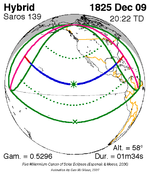 December 9, 1825 (Saros 139) |  November 20, 1854 (Saros 140) |  October 30, 1883 (Saros 141) |
 October 10, 1912 (Saros 142) |  September 21, 1941 (Saros 143) |  August 31, 1970 (Saros 144) |
 August 11, 1999 (Saros 145) |  July 22, 2028 (Saros 146) |  July 1, 2057 (Saros 147) |
 June 11, 2086 (Saros 148) | 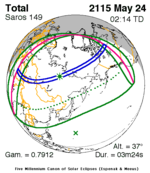 May 24, 2115 (Saros 149) |  May 3, 2144 (Saros 150) |
 April 12, 2173 (Saros 151) | ||
Notes
- ^ "October 10, 1912 Total Solar Eclipse". timeanddate. Retrieved 31 July 2024.
- ^ "SOLAR ECLIPSE. Disappointed Scientists". Manchester Evening News. Manchester, Greater Manchester, England. 1912-10-11. p. 6. Retrieved 2023-11-03 – via Newspapers.com.
- ^ "TOTAL ECLIPSE OF THE SUN OCT. 10". Martinsburg Statesman-Democrat. Martinsburg, West Virginia. 1912-10-11. p. 2. Retrieved 2023-11-03 – via Newspapers.com.
- ^ "SOLAR ECLIPSE FAILURE". Leicester Mercury. Leicester, Leicestershire, England. 1912-10-11. p. 5. Retrieved 2023-11-03 – via Newspapers.com.
- ^ "Moon Distances for London, United Kingdom, England". timeanddate. Retrieved 31 July 2024.
- ^ Helmut Hornung (26 May 2015). "A solar eclipse sheds light on physics". Phys.org. Archived from the original on 26 November 2020.
- ^ "GENERAL NOTES". Astronomical Society of the Pacific. December 1912. pp. 288–290. Archived from the original on 28 August 2019.
- ^ "Total Solar Eclipse of 1912 Oct 10". EclipseWise.com. Retrieved 31 July 2024.
- ^ van Gent, R.H. "Solar- and Lunar-Eclipse Predictions from Antiquity to the Present". A Catalogue of Eclipse Cycles. Utrecht University. Retrieved 6 October 2018.
- ^ "NASA - Catalog of Solar Eclipses of Saros 142". eclipse.gsfc.nasa.gov.
Additional reading
- Paolantonio, Santiago (2019). "Eclipse de 1912 en Brasil. Primera tentativa de medir la deflexión de la luz y comparar con el valor propuesto por Einstein de 1911" [Eclipse of 1912 in Brazil. First attempt to measure the deflection of light and its comparison with the value proposed by Einstein in 1911]. Revista Brasileira de Ensino de Física (in Spanish). 41 (suppl 1). doi:10.1590/1806-9126-rbef-2019-0206. ISSN 1806-9126. S2CID 213858006.
References
- Earth visibility chart and eclipse statistics Eclipse Predictions by Fred Espenak, NASA/GSFC
- Google interactive map
- Besselian elements
- v
- t
- e
| By era | |
|---|---|
| Saros series (list) | |
| Visibility | |
| Historical |
|

Total/hybrid eclipses
→ next total/hybrid
- 1133
- 1185
- 1560
- 1598
- 1652
- 1654
- 1673
- 1706
- 1715
- 1724
- 1766
- 1778
- 1780
- 1806
- 1816
- 1824
- 1842
- 1851
- 1853
- 1857
- 1858
- 1860
- 1865
- 1867
- 1868
- 1869
- 1870
- 1871
- 1874
- 1875
- 1878
- 1882
- 1883
- 1885
- 1886
- 1887
- Jan. 1889
- Dec. 1889
- 1893
- 1896
- 1898
- 1900
- 1901
- 1903
- 1904
- 1905
- 1907
- Jan. 1908
- Dec. 1908
- 1909
- 1910
- 1911
- Apr. 1912
- Oct. 1912
- 1914
- 1916
- 1918
- 1919
- 1921
- 1922
- 1923
- 1925
- 1926
- 1927
- 1928
- 1929
- Apr. 1930
- Oct. 1930
- 1932
- 1934
- 1936
- 1937
- 1938
- 1939
- 1940
- 1941
- 1943
- Jan. 1944
- 1945
- 1947
- 1948
- 1950
- 1952
- 1954
- 1955
- 1956
- 1957
- 1958
- 1959
- 1961
- 1962
- 1963
- 1965
- 1966
- 1967
- 1968
- 1970
- 1972
- 1973
- 1974
- 1976
- 1977
- 1979
- 1980
- 1981
- 1983
- 1984
- 1985
- 1986
- 1987
- 1988
- 1990
- 1991
- 1992
- 1994
- 1995
- 1997
- 1998
- 1999
- 2001
- 2002
- 2003
- 2005
- 2006
- 2008
- 2009
- 2010
- 2012
- 2013
- 2015
- 2016
- 2017
- 2019
- 2020
- 2021
- 2023
- 2024
- → 2026
- 2027
- 2028
- 2030
- 2031
- 2033
- 2034
- 2035
- 2037
- 2038
- 2039
- 2041
- 2042
- 2043
- 2044
- 2045
- 2046
- 2048
- 2049
- 2050
- 2052
- 2053
- 2055
- Jan. 2057
- Dec. 2057
- 2059
- 2060
- 2061
- 2063
- 2064
- 2066
- 2067
- 2068
- 2070
- 2071
- 2072
- 2073
- 2075
- 2076
- 2077
- 2078
- 2079
- 2081
- 2082
- 2084
- 2086
- 2088
- 2089
- 2090
- 2091
- 2093
- 2094
- 2095
- 2096
- 2097
- 2099
- 2100
- 2186

Annular eclipses
→ next annular
- 1820
- 1854
- 1879
- 1889
- 1900
- 1901
- 1903
- 1904
- 1905
- 1907
- 1908
- 1911
- 1914
- Feb. 1915
- Aug. 1915
- 1916
- 1917
- 1918
- 1919
- 1921
- 1922
- 1923
- 1925
- 1926
- 1927
- 1929
- 1932
- Feb. 1933
- Aug. 1933
- 1934
- 1935
- 1936
- 1937
- 1939
- 1940
- 1941
- 1943
- Jul. 1944
- 1945
- 1947
- 1948
- 1950
- Mar. 1951
- Sep. 1951
- 1952
- Jan. 1954
- Dec. 1954
- 1955
- 1957
- 1958
- 1959
- 1961
- 1962
- 1963
- 1965
- 1966
- Mar. 1969
- Sep. 1969
- 1970
- 1972
- Jan. 1973
- Dec. 1973
- 1976
- 1977
- 1979
- 1980
- 1981
- 1983
- 1984
- 1987
- 1988
- 1990
- 1991
- 1992
- 1994
- 1995
- 1998
- 1999
- 2001
- 2002
- 2003
- 2005
- 2006
- 2008
- 2009
- 2010
- 2012
- 2013
- 2014
- 2016
- 2017
- 2019
- 2020
- 2021
- 2023
- → 2024
- 2026
- 2027
- 2028
- 2030
- 2031
- 2032
- 2034
- 2035
- 2036
- Jan. 2038
- Jul. 2038
- 2039
- 2041
- 2042
- 2043
- 2044
- 2045
- 2046
- 2048
- 2049
- 2052
- 2053
- Jan. 2056
- Jul. 2056
- 2057
- 2059
- 2060
- 2061
- 2063
- 2064
- 2066
- 2067
- 2070
- 2071
- Jan. 2074
- Jul. 2074
- 2075
- 2077
- 2078
- 2079
- 2081
- 2082
- 2084
- Jun. 2085
- Dec. 2085
- 2088
- 2089
- Feb. 2092
- Aug. 2092
- 2093
- 2095
- 2096
- 2097
- 2099
- 2100

Partial eclipses
→ next partial
- Jan. 1639
- Apr. 1902
- May 1902
- Oct. 1902
- Feb. 1906
- Jul. 1906
- Aug. 1906
- Dec. 1909
- Nov. 1910
- Apr. 1913
- Aug. 1913
- Sep. 1913
- Dec. 1916
- Jan. 1917
- Jun. 1917
- Jul. 1917
- May 1920
- Nov. 1920
- Mar. 1924
- Jul. 1924
- Aug. 1924
- Dec. 1927
- Jun. 1928
- Nov. 1928
- Apr. 1931
- Sep. 1931
- Oct. 1931
- Jan. 1935
- Feb. 1935
- Jun. 1935
- Jul. 1935
- Nov. 1938
- Mar. 1942
- Aug. 1942
- Sep. 1942
- Jan. 1946
- May 1946
- Jun. 1946
- Nov. 1946
- Apr. 1949
- Oct. 1949
- Feb. 1953
- Jul. 1953
- Aug. 1953
- Dec. 1956
- Mar. 1960
- Sep. 1960
- Jan. 1964
- Jun. 1964
- Jul. 1964
- Dec. 1964
- May 1967
- Mar. 1968
- Feb. 1971
- Jul. 1971
- Aug. 1971
- Dec. 1974
- May 1975
- Nov. 1975
- Apr. 1978
- Oct. 1978
- Jan. 1982
- Jun. 1982
- Jul. 1982
- Dec. 1982
- May 1985
- Apr. 1986
- Mar. 1989
- Aug. 1989
- Dec. 1992
- May 1993
- Nov. 1993
- Apr. 1996
- Oct. 1996
- Sep. 1997
- Feb. 2000
- 1 Jul. 2000
- 31 Jul. 2000
- Dec. 2000
- Apr. 2004
- Oct. 2004
- Mar. 2007
- Sep. 2007
- Jan. 2011
- Jun. 2011
- Jul. 2011
- Nov. 2011
- Oct. 2014
- Sep. 2015
- Feb. 2018
- Jul. 2018
- Aug. 2018
- Jan. 2019
- Apr. 2022
- Oct. 2022
- → Mar. 2025
- Sep. 2025
- Jan. 2029
- Jun. 2029
- Jul. 2029
- Dec. 2029
- 2032
- 2033
- Feb. 2036
- Jul. 2036
- Aug. 2036
- 2037
- May 2040
- Nov. 2040
- Jan. 2047
- Jun. 2047
- Jul. 2047
- Dec. 2047
- 2050
- Apr. 2051
- Oct. 2051
- Mar. 2054
- Aug. 2054
- Sep. 2054
- 2055
- May 2058
- Jun. 2058
- Nov. 2058
- Mar. 2062
- Sep. 2062
- Feb. 2065
- Jul. 2065
- Aug. 2065
- Dec. 2065
- 2068
- Apr. 2069
- May 2069
- Oct. 2069
- 2072
- 2073
- Jun. 2076
- Jul. 2076
- Nov. 2076
- Feb. 2083
- Jul. 2083
- Aug. 2083
- 2084
- 2086
- May 2087
- Jun. 2087
- Oct. 2087
- 2090
- 2091
- Jun. 2094
- Jul. 2094
- Dec. 2094
- Apr. 2098
- Sep. 2098
- Oct. 2098
 Astronomy portal
Astronomy portal Solar System portal
Solar System portal Category
Category












